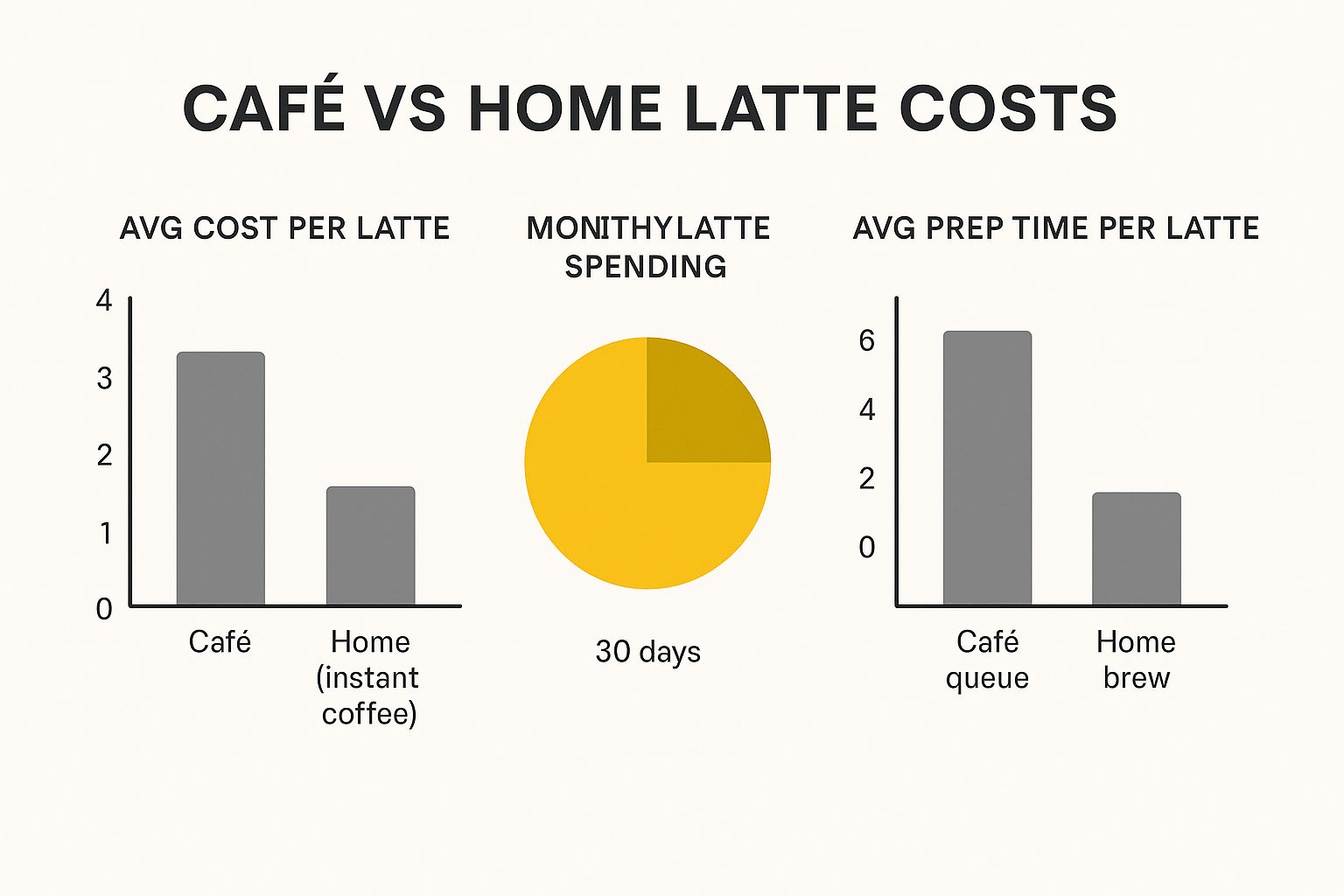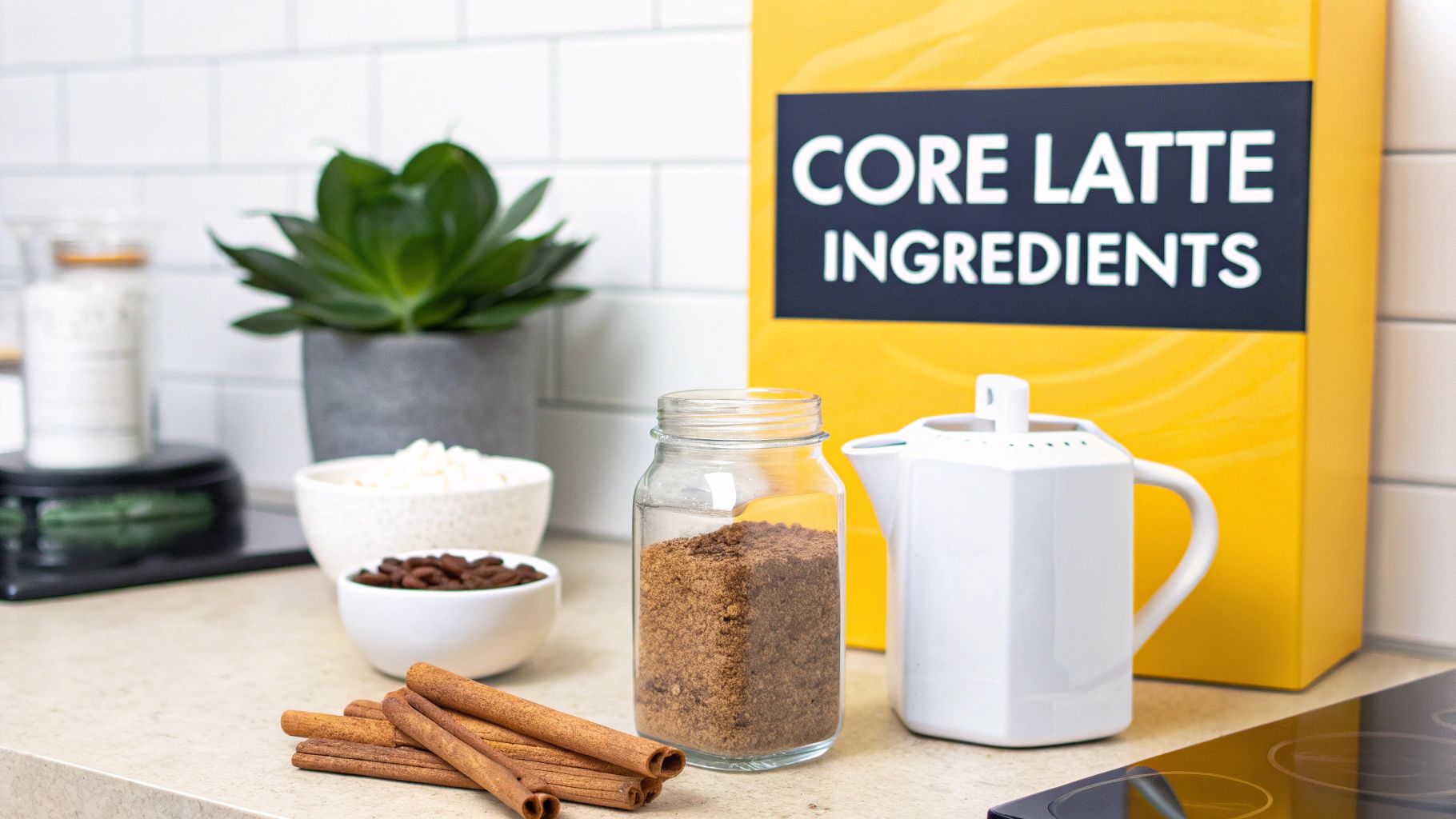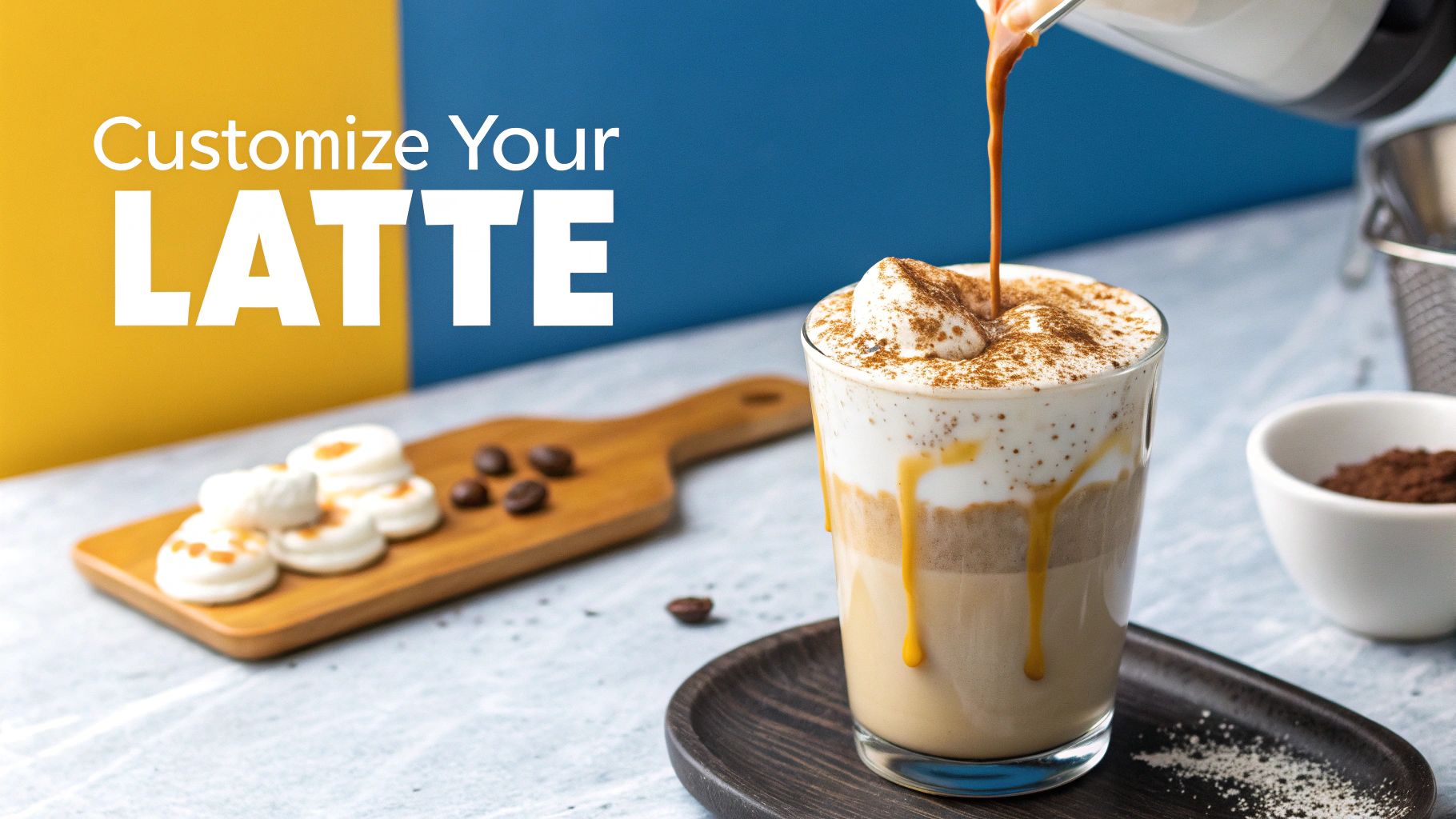Making a truly great instant coffee latte right in your own kitchen is surprisingly simple. Forget everything you think you know about instant coffee—when you start with a premium one, like the blends from Cartograph Coffee, you get a rich, complex base that stands up beautifully to frothed milk. This is how you become your own favorite barista.
Why Your Kitchen Is the New Coffee Shop
Let's be honest, the daily cafe run can be a grind. The waiting, the cost... it adds up. When you start making your own drinks, you quickly realize it's not just about saving a few bucks. It's about having your perfect coffee, exactly how you like it, the moment you want it. You're in complete control, from the type of milk to the exact level of sweetness.
This isn't just a niche hobby, either. The global market for instant lattes is massive, valued at around $7.062 billion as of 2025. This isn't a coincidence. People everywhere are looking for high-quality coffee that fits into their packed schedules. You can dig into the numbers in this market analysis.
The Real-World Benefits
The perks of a homemade latte go way beyond good taste. They're practical, tangible benefits you'll feel every single day.
- Serious Cost Savings: That daily $5 latte adds up. Switching to a homemade routine can literally save you hundreds, if not thousands, of dollars a year.
- Unbeatable Convenience: Your perfect latte is ready in less than five minutes. That’s a game-changer on a busy morning.
- Total Creative Freedom: Feel like an oat milk latte with a dash of cinnamon today? Or maybe a caramel almond milk creation tomorrow? No extra charges, no complicated orders. Just pure creativity.
This little breakdown really puts the difference between a cafe latte and a homemade one into perspective.

The numbers don't lie—the savings in both time and money are huge. It just makes sense. Once you get a few simple steps down, you'll be set. We've got more tips on the best way to prepare coffee at home that can help you nail your technique.
Choosing Your Core Latte Ingredients

Any great latte, even one made in a flash, comes down to the quality of its parts. It might seem simple, but each ingredient pulls its weight, shaping the final taste and texture. A little thought here goes a long way.
The heart of your latte is, of course, the coffee. It’s the flavor foundation. Let's be honest—most standard instant coffee from the grocery store aisle uses lower-grade robusta beans and harsh processing. The result is often a flat, sometimes bitter, coffee that just doesn't cut it.
If you want a latte that genuinely stacks up against your favorite cafe's, you need to start with a specialty instant coffee. We use Cartograph Coffee because it’s made from high-quality arabica beans and freeze-dried to lock in all those complex, delicate flavor notes. It dissolves into a genuinely smooth and rich concentrate that tastes like a proper brewed coffee. This is easily the single biggest upgrade you can make to your at-home latte game.
If you want to dig deeper into what makes a quality instant coffee, our guide to the best instant coffee packets is a great resource.
Selecting the Perfect Milk
Next up is the milk, which dictates the creaminess, froth, and overall flavor profile of your drink. There's really no wrong answer here; it's all about what you like and the kind of texture you're chasing.
Dairy milk, particularly whole milk, is the classic choice for a reason. It has the perfect balance of fat and protein to create a rich, dense, and stable foam that’s a dream to pour.
Plant-based milks are also fantastic options, and each one brings something unique to the table. Oat milk has become a superstar for its creamy texture and relatively neutral flavor, making it froth up beautifully. Almond milk is a bit lighter and adds a subtle nutty background note, while soy milk is a protein-heavy choice that also froths surprisingly well.
For those struggling to get that perfect cafe-style foam from non-dairy options, I've put together a quick cheat sheet.
Milk Frothing Potential for Your Latte
The type of milk you choose can make or break your foam. Here’s a quick rundown of what to expect from the most common options.
| Milk Type | Frothing Capability | Flavor Profile | Best For |
|---|---|---|---|
| Whole Milk | Excellent | Rich & Creamy | Classic latte art and texture |
| Oat Milk | Very Good | Mild & Sweet | A creamy, dairy-free alternative |
| Soy Milk | Good | Distinct, beany flavor | A high-protein option that holds foam well |
| Almond Milk | Fair | Light & Nutty | Lighter lattes with a subtle flavor |
Ultimately, don't be afraid to experiment. Finding your favorite milk is part of the fun of crafting the perfect homemade latte.
Pro Tip: If you're using a non-dairy milk, always reach for the "barista blend" if you can find it. These are specifically formulated with a few extra ingredients that help them create that velvety, stable microfoam we all love. It makes a huge difference.
Sweeteners and Flavors
This is where you get to play and really make the drink your own. A little sweetness or a dash of flavor can elevate your latte from good to fantastic.
- Classic Sweeteners: You can't go wrong with simple syrup (just dissolve equal parts sugar in hot water) because it mixes in instantly. Maple syrup or honey also work well, lending a more natural, earthy sweetness.
- Simple Spices: A dash of cinnamon or a light sprinkle of cocoa powder before you pour your milk can add wonderful warmth and complexity.
- Flavor Extracts: Want to feel like a real barista? A few drops of pure vanilla or even almond extract can completely transform your latte into a gourmet treat.
Creating a Smooth Espresso-Style Base
The secret to a café-quality instant coffee latte isn't just dumping powder into hot water. It's all about crafting a strong, smooth coffee concentrate that mimics a shot of real espresso. This little detail is what separates a mediocre drink from a fantastic one.
Think of this base as the heart of your latte. It has to be bold enough to stand up to all that creamy milk you're about to add.
Getting the Ratios and Technique Just Right
Forget guesswork. For a perfectly balanced and robust flavor, start with one to two teaspoons of Cartograph Coffee. Mix it with just two tablespoons of hot water. This creates that potent, syrupy liquid we're aiming for.
Why so little water? This strong concentrate is the key to preventing a watery, disappointing latte. It ensures those rich coffee notes shine through instead of getting lost.
Now, let's talk about water temperature, because it makes a huge difference. You need hot water, but boiling water is the enemy of good flavor. Anything over 200°F (93°C) can scorch the delicate coffee, leaving you with a bitter, burnt taste.
A good rule of thumb is to let your kettle sit for about 30 seconds after it clicks off. That’s the sweet spot.
Here's a pro tip: Instead of pouring hot water directly onto the granules, add a splash of cold water first. Mix it into a paste, then stir in the hot water. This little trick helps the coffee dissolve perfectly without any clumps.
This kind of careful approach is becoming more common as people demand better-tasting convenient coffee. The instant coffee market is actually projected to hit $58.73 billion by 2032, driven by people like us who want quality without the hassle.
Perfecting your coffee base is a simple skill with a massive payoff. If you want to dive deeper, we have a whole guide on how to make instant coffee taste better.
Getting That Velvety Milk Foam Without Fancy Gear

Let's be honest, the soul of a great latte is that silky, steamed milk. That luxurious texture feels like a cafe-only treat, but it doesn't have to be. You can get that beautiful, pourable microfoam right in your own kitchen using tools you probably already own.
Forget the idea that you need a high-pressure steam wand. A few clever, low-tech methods can whip air into heated milk, giving you the stable foam that makes an instant coffee latte truly special.
The Handheld Frother: Quick and Easy
This little battery-operated gadget is a game-changer for any latte lover. It’s my go-to when I'm short on time because it’s fast, effective, and a breeze to clean.
First, warm your milk on the stovetop or in the microwave. You're aiming for around 150°F (65°C)—it should feel hot to the touch, but definitely not boiling. Pour the warm milk into a tall mug, leaving enough headroom for it to expand.
Dip the whisk just below the surface and switch it on. As the foam starts to form, slowly lower the frother deeper into the milk. This pulls air all the way through, creating a consistent texture. After about 20-30 seconds, you'll have perfect milk ready for your coffee.
The Sealed Jar Trick: Surprisingly Effective
No frother? No problem. All you need is a clean glass jar with a lid that seals tightly. This technique always surprises people with how well it works.
Just pour cold milk into the jar, filling it no more than halfway. Screw the lid on tight and shake it like you mean it for 30 to 60 seconds. You're looking for the milk to nearly double in volume.
Once it's nice and frothy, take off the lid and pop the jar in the microwave for about 30 seconds. This is the key step—the heat sets the foam, giving it that velvety structure you want for a latte.
The French Press Plunge
For what I think is the best machine-free microfoam, grab your French press. The fine mesh screen is absolutely perfect for creating tiny, uniform bubbles. Pour your warm milk into the press (again, only about half full) and pump the plunger up and down quickly for about 30 seconds. The result is a silky, dense foam that’s amazing for pouring and even trying your hand at some basic latte art. Honestly, this has become my favorite way to get a cafe-quality finish at home.
Bringing It All Together and Making It Your Own

Alright, this is where the magic happens. You’ve got your rich, concentrated coffee base and a pitcher of perfectly frothed, velvety milk. Now, let’s combine them into a beautiful latte.
The key to a great pour is control. Start by tilting your mug with the coffee in it. Then, pour the frothed milk steadily right into the center of the coffee. As the mug starts to fill, slowly bring it back to a level position. This simple technique helps the milk and coffee blend together beautifully, creating that creamy texture we all love, topped with a perfect little cap of foam.
Get Creative and Customize Your Latte
This is your chance to turn a simple instant coffee latte into something truly special. Think of this basic recipe as a blank canvas. A few personal touches can completely transform your drink.
Here are a few of my favorite ways to jazz things up:
- A Touch of Sweetness: You can't go wrong with a classic drizzle of caramel or chocolate syrup. It looks fantastic and adds that extra bit of indulgence. If you want something a little different, a touch of real maple syrup is a game-changer.
- Warm Spices: For a cozy feel, try dusting the top with a bit of ground cinnamon or nutmeg. It adds a wonderful aroma and a subtle warmth to the flavor. I sometimes add a tiny pinch of cardamom, which pairs surprisingly well with the coffee.
- Gourmet Flavors: Add a few drops of pure vanilla or almond extract directly into your coffee base before you pour the milk. It's a simple trick that gives your latte a sophisticated, café-quality taste.
It turns out, making lattes at home is a huge deal worldwide. The Asia Pacific region makes up about 42% of the entire latte instant coffee market, thanks to a deeply rooted coffee culture. In fact, the regular latte segment accounts for nearly 60% of the market's total volume. You can dig into more of these fascinating stats in the instant coffee market report from datahorizzonresearch.com.
Troubleshooting Your Instant Latte
Even the simplest recipes can have a few hiccups. If your homemade instant coffee latte isn't quite hitting the mark, don't worry. Let's walk through a few common snags and how to fix them, so you can get that perfect cafe-quality drink right in your own kitchen.
What About an Iced Latte?
You can absolutely make this an iced latte, and it's just as easy. The trick is to start the same way: dissolve your Cartograph Coffee in a small splash of hot water. This creates that essential, potent coffee concentrate.
Let it cool for a minute, then grab a tall glass and fill it with ice. Pour in your cold milk of choice, followed by the coffee concentrate. Stir everything together, add your favorite sweetener, and you're good to go. If you want to get a little fancy, use a handheld frother on a bit of your cold milk to whip up a creamy cold foam for the top.
Why Does My Coffee Taste Bitter?
If your instant coffee has a harsh, bitter bite, it usually comes down to one of two things: your water was too hot, or the coffee itself isn't great quality.
Boiling water actually scalds the coffee granules, leaving you with a burnt taste. You want the water hot, but not scorching. Aim for a temperature around 195°F (90°C) for the best results.
If you’ve got the temperature right and still taste bitterness, it’s probably the coffee. A high-quality specialty instant coffee is crafted to bring out smooth, rich notes without that unpleasant aftertaste common in lower-grade brands.
My Milk Isn't Frothing!
This is a classic problem. If your milk just isn't foaming, the issue is usually related to protein content or fat residue. For dairy, always start with fresh, cold milk—whole or 2% works best because they have the perfect balance of proteins and fats for a stable foam. For plant-based options, look for a "barista blend," as they're specifically formulated to froth well. And a pro tip: make sure your frothing wand or pitcher is sparkling clean. Even a tiny bit of oil can completely ruin your foam.
Ready to skip the troubleshooting and start with a rich, smooth base every time? Explore the premium, organic blends from Cartograph Coffee and taste the difference for yourself. Shop our collection today!